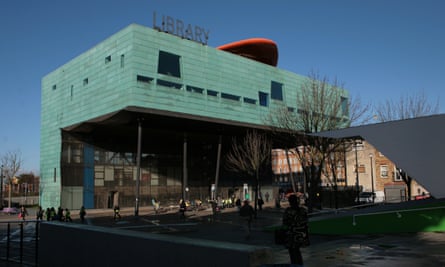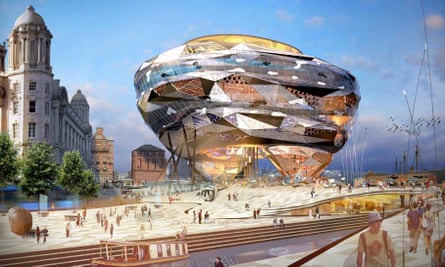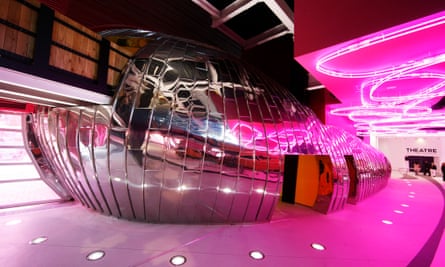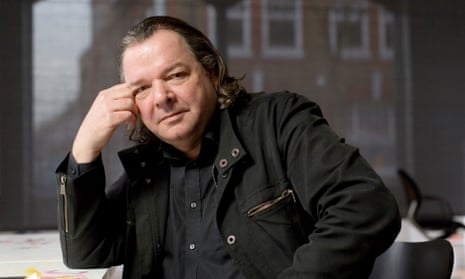Will Alsop proposed turning Barnsley into a Tuscan hill town, flooding the centre of Bradford with a huge lake and adorning Middlesbrough with towers in the shape of Prada skirts. The maverick British architect, who has died aged 70, shook the establishment with his wild and wacky visions, which were often too harebrained for reality to bear. More interested in bold ideas than the financial practicalities of running a business, Alsop had a colourful career chequered by receivership and buyouts, which saw his firm take on six different guises over his four decades of practice.
His most celebrated building was Peckham Library, an audacious arrival to a deprived part of south London, standing on the edge of a square as a bright green inverted L-shape, crowned with a jaunty orange beret. Winner of the 2000 Stirling prize, it caught the millennial zeitgeist and changed the idea of what a 21st-century library could be. The double-height reading room was lifted up 12 metres in the air, raised on the architect’s trademark wonky columns above the square, containing curvaceous wooden pods that were also jacked up above the shelves on angled stilts. It captured the public imagination and had the desired effect of attracting younger readers: the library welcomes three times the borough’s average of 15- to 17-year-old members.

Making buildings levitate proved to be one of Alsop’s lifelong themes, exemplified in his black-and-white-spotted extension to the Ontario College of Art & Design in 2004, which hovers on coloured poles above an existing building like a flying Dalmatian. “If I were a politician,” he said in an interview, “I would make a law in every city that everything from the ground to 10 metres and higher should float and not touch the ground … The ground should be given to people and gardens, not buildings.”
Son of Francis Alsop, an accountant, and Brenda Hight, Alsop was born in Northampton. He left school at 16, when his father died, and chose to do his A-levels at evening classes while working for a local architect. He completed a foundation course at Northampton Art School before studying in London at the Architectural Association (AA), where he came runner-up in the competition for the Pompidou Centre in Paris, aged 23. After graduating in 1973, he worked briefly for Maxwell Fry and Jane Drew, who had been instrumental in introducing modernism to Britain in the 1930s, then joined Cedric Price for four years, an architect whose radical visions, always laced with humour, proved to be of lasting influence.
After founding Alsop & Lyall in 1981, with his AA classmate John Lyall, Alsop’s first commission was a swimming pool in Sheringham, Norfolk, in 1984, followed by a tubular visitor centre in Cardiff Bay (since demolished). The two parted company in 1991, when the practice became known as Alsop & Störmer and went on to build the Hamburg ferry terminal and a gigantic blue wave-like complex for the regional government in Marseille in 1994, nicknamed “the Big Blue”. They used the same deep indigo colour in the mosaic tiles that clad the angled columns of North Greenwich tube station, built in 1998, bringing a splash of joy to the Underground. “Architects are the only profession that actually deal in joy and delight,” said Alsop. “All the others deal in doom and gloom.”
He decided to go it alone in 2000, founding Alsop Architects the same year he was elected to the Royal Academy and bagged the Stirling; he had been appointed OBE the previous year. Enjoying the media spotlight, he began working on a series of “visioning studies” for post-industrial northern cities that were looking for a “wow factor” to put themselves on the map. For Middlesbrough he concocted a £500m plan for the former docks, including a shimmering hotel in the shape of a champagne bottle and an office block modelled on Marge Simpson’s hairdo. He proposed to surround Barnsley with a “living wall” of more glowing novelty forms, while Bradford, Stoke and Halifax were subject to equally eccentric (and mostly still unrealised) plans.

To his critics, Alsop was a reckless pied piper, duping desperate mayors of struggling cities into commissioning madcap schemes they could never hope to build. To his fans he was a mischievous breath of fresh air, injecting a welcome dose of colour and energy into a profession that was all too beige. Alsop always argued that his headline-catching proposals brought these towns the kind of media attention and developers’ cheque books that they would not otherwise have received; but the lasting effect of his toy-town dreamscapes remains questionable.
One of his biggest blows came in 2004, when Liverpool city council cancelled his proposed Fourth Grace, a contorted glass cloud on legs planned for the city’s waterfront, which was variously described as a “diamond knuckleduster” and a “cow pat”. His practice went into receivership that year, with 40% sold to a venture capitalist firm, and he was dropped from a £350m plan for Birmingham New Street station. Three years later he was forced to sell his business to a corporate conglomerate, SMC Group, in a dramatic fall from grace that he blamed on clients being too timid. “Of all the countries in the world, the UK is the most risk-averse group of people there is,” he said. “In London we are not being hired to design the office buildings we should because of a perception we are a risk and might not get planning permission.”

The acquisition heralded a steady decline in Alsop’s reputation, confounded by the high-profile failure of the Public, a £72m arts centre in West Bromwich in the form of a huge black shed filled with interactive exhibits of uncertain use. In a damning report in 2011, the Arts Council England – which contributed £31m as well as £600,000 a year to fund the programme – concluded that it had “agreed to fund a building that was not fit for purpose”. It went into administration a year after opening and closed in 2013, to be converted into a sixth-form college.
A self-styled enfant terrible, Alsop was usually dressed in a crumpled jacket, with long hair, and never to be found far from a bottle of wine and packet of cigarettes. He was a keen painter too, and would take a month off every summer to paint in Majorca with his friend Bruce McLean, while a wall of his office was always devoted to a large canvas where he would daub colourful abstract compositions with colleagues.
“One of the reasons for painting is that you are not really in control of what you are doing,” he said, “and that interests me a lot. Instead of having a specific starting point, which perhaps, in architectural terms, would lead through to a series of logical thoughts working towards a designed building, you can start anywhere.”

In 2009 Alsop made the dramatic announcement that he was retiring from architecture “to concentrate on painting”, but it was merely another media-savvy ruse. Three months later, he reappeared as a director of RMJM, a long-standing corporate practice, under the title “Will Alsop at RMJM” (“It sounds a bit like Gordon Ramsay at Claridge’s, doesn’t it?” he quipped). It was an unlikely marriage that lasted only two years. He left to set up aLL Design in 2011, supported by anonymous financial backers.
Moving his studio across London from Battersea to Hackney, he enjoyed a renewed freedom towards the end of his life, receiving a number of commissions in China, where he found a receptive audience for his fantastical masterplans among the recently-minted billionaire developer class. He opened an office in Chongqing, where his practice is building a new cultural quarter around their studio, with a restaurant, bar and distillery, as well as planning an enormous agricultural leisure park in Yubei, 20 miles north of the city. The landscape will be dotted with cocoon-like treehouses, a flower-shaped hotel and a big lake covered by an LED-screen canopy, so visitors can enjoy artificial blue skies despite the smog.
He is survived by his wife, Sheila (nee Bean), whom he married in 1972, and two sons, Oliver and Piers, and a daughter, Nancy.
